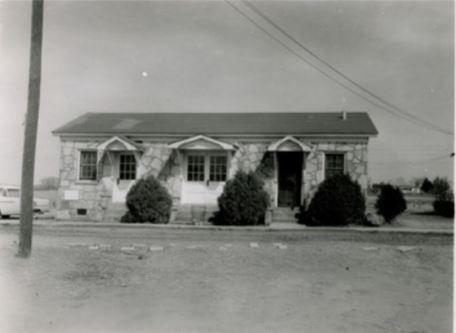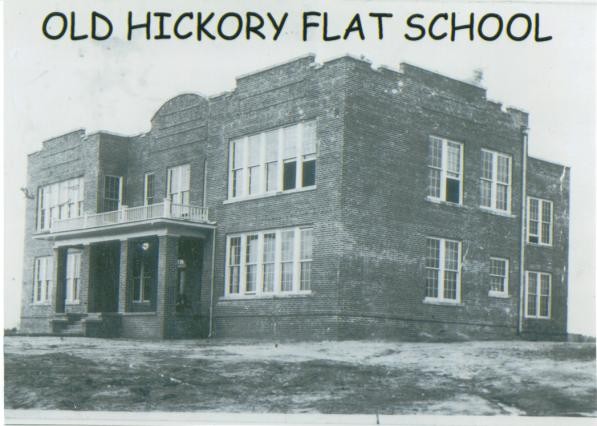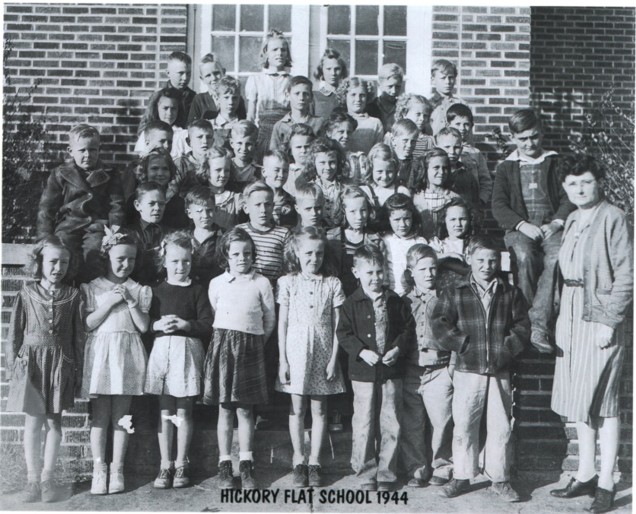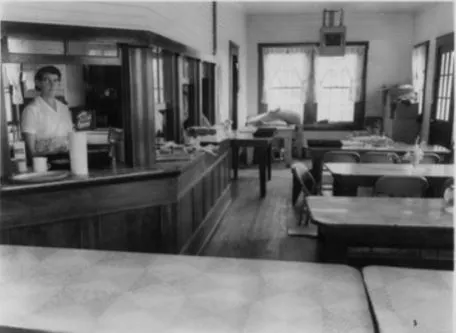THE HISTORY OF HICKORY FLAT SCHOOL
By Vera Perkins
Delivered at the Centennial Celebration, November 6, 1993

First, I want to settle the mystery as to why I was asked by the other members of the Centennial Committee to give the history of the school. I was a little puzzled about this at first, but I think some of Ladonna Moorehead's students solved the mystery for me. A few days ago I had to go to her classroom to see one of her students and she laughingly told me at lunch what they said after I left. One of them said, "Surely Mrs. Perkins has had a facelift because she doesn't look
nearly as old as she would have to be." I decided they think I came with this building and I guess I almost did since the first graduating class in this building was the year before I was born.
It is very difficult to give a history of the school of Hickory Flat without incorporating some of the town's history with it. I believe to do this justice, I must give some facts about the town, hoping this will be interesting and new to most of you.
Hickory Flat was named by early settlers because most of the hills and valleys were covered with hickory trees. Eli Crum and Joseph Morman were the earliest recorded settlers of "old" Hickory Flat followed by the Ben Johnson, Hiram Calhoun, Joe Johnson, and Fred Holland families. During the Civil War days, Confederate and Union soldiers were common to settlers of old Hickory Flat.
The town was originally located approximately two miles east of the old Hickory Flat cemetery. The Crums and Mormans came in 1837 and built houses on nearby hills and there were only a few clear patches of land to be used for cultivation. History reveals that Indians were driven out of this area only a short time before this settlement by these two families who were joined a short time later by other settlers and a small village began to form on the old Chickasaw Trail from Pontotoc to Memphis
From the information I could find, the first schoolhouse in Hickory Flat was in "old" Hickory Flat and stood in the general area of the house now owned by James Roy and Mary Alice Crisco on Highway 2. One of our local residents, Mrs. Hardy West, told me that she attended that school and completed the 11th grade there which was as far as the school went. It seems that most of the early schools did not include the 12th grade as we now do.
In 1886 when the railroad from Memphis to Holly Springs was continued on to Amory, old Hickory Flat began to change. A depot was constructed alongside the railroad in 1882 and Hickory Flat began to move to the area that became known as "New" Hickory Flat, leaving only the old Hickory Flat cemetery to mark what is now called old Hickory Flat. Hickory Flat, as we know it today, was incorporated March 7, 1888, with some of the earliest families being the Blakeslees, McKays, Reynolds, Walkers, Gadds, Laws, Rosses, Coltharps, Fraziers, Rowans, Carruths, Graves, and Brights, in addition to the Crums and Mormans already mentioned.
It is interesting to note that before "New" Hickory Flat had a school, a college was organized. Hickory Flat Normal College was incorporated on June 24, 1892, the year before the first school was organized. The college charter names W. A. Crum, C. L. Crum, and W. E. Crum as founders. The charter states: "The founders shall have the power to prescribe terms of admission to college classes, to confer degrees and award diplomas, to grant certificates of proficiency and all other acts for the encouragement of learning." This document bears the seal of J. M. Stone, Governor of Mississippi. My information states that this college was on the site of the high school that was founded the next year.
The location of the first school in Hickory Flat was in the block where the present Methodist Church and the Hickory Flat Quick Stop owned by Steve Floyd stand. I suppose this is the general area of the Normal College as well. A document belonging to the late Mrs. Thelma Ross Prude, states: “On the 28th day of March, 1893, J. L. Crawford, F. M. Ross, W. B. Whittington, J. T. Abston, J. W. Whiteside, and J. C. Coltharp formed into a company for the purpose of creating a school building in the Village of Hickory Flat. It is hereby agreed that we each shall contribute an equal one-sixth of the amount of money necessary to the creation, completion, and operation of said building." C. T. Blakeslee was mayor and signed the document. Mr. E. H. Wallis was the teacher of this school in the 1893-94 school year and the building burned in 1916 or 1917.

I have been unable to find out when the two-story brick school, which stood on the hill behind the present gym was built, but I believe it was in 1921, according to what I’ve been told. I do have a record of the 1924 class members, so in the years between the destruction by fire of the first school in '16 or '17 and the year of 1924 the two-story building was constructed. According to some 1935 graduates of HFHS, it was a nice building and even had indoor bathrooms!
I was also told that when this school opened, many of the small one-room schools in the area were closed and the children were brought to this school in school wagons, not buses. Also, some students boarded with town people during the winter because there was no transportation during the bad winter weather and that was the only way they could go to school. Many of the local, older, residents that I talked with referred to this school as the "Consolidated" school. The first Agriculture/Home Economics classes were begun at this school in the 1930-31 school year. During the 1933 school year, this building also burned. It burned during the night and I've been told that the fire could be seen as far away as Myrtle and that some students laughed and others cried when they heard the news that the school had burned. To complete the school year, classes were held in the gym and the 1933 graduating class held their ceremony in the gym. The gym that I am referring to now was the old wooden structure that stood just a few feet behind the present building. It seems that the Hickory Flat School System has been plagued by fires through the years, as this gym also burned, I believe in 1945 or 46. I was in elementary school when it burned and I remember well standing on the playground in the area between this building and the present gym watching it burn. I also remember seeing high school boys, I believe Kenneth Wicker and Charles Hunter, along with several others watering down the roof of this building to prevent its burning. I'm sure a lot of you remember practicing basketball on the dirt court on the hill past the agriculture building during the time it took to build the gym that we have now.

After the two-story building was destroyed in 1933, construction of the present building was begun. It is interesting to note that the original structure was in the shape of the letter H. I always have wondered if that was representative of the H in Hickory Flat. The first graduation for a senior class in this building was 1934. Members of this class were Lois Ross, Helen Abston, Mitchell Blythe, Raymond Thompson, Elizabeth Autry, Walter Cochran, Claude Thompson, Mabel Potter, Ethel Renick, Edna Williams, Grace Daniel, and Greer Wallace. Mr. F. Skiles, was the principal and the senior class sponsor.The building remained unchanged until the 1950s when two additional classrooms were added to the end of the East Hall and the Home-Economics room and Lunchroom were added to the end of the West Hall. Many internal changes have been made through the years to accommodate changing educational patterns, but the exterior has remained pretty much the same. The building which is now used for the science classes, was used as a lunchroom before the present one was built.
Before the burning of the gym, it served a two-fold purpose; one for basketball practice and games (I also remember once attending a donkey basketball game in that gym) but for the lunchroom as well. According to what I've been told by former students, they called it the "soup kitchen." They say it was called this because they had soup every day. They would go into the gym and through one of the side rooms to get their bowl of soup and cornbread, along with a cup of hot chocolate and take their food to the bleachers where they sat and ate their lunch. I wonder what the State Department of Education and the State Health Department would have to say about that kind of lunchroom now.
During the 1960's when additional space was needed for classrooms, mobile units were moved in and set up to accommodate elementary classes. After these units became worn out, and bond issues failed, we were told that there was no state or local money for the construction of a new elementary building which we desperately needed. The elementary building that some of you have already toured today is the result of a community pulling together and making up its mind that education of its children was important. Through the leadership of a very able president, Jimmy Gresham, the Parent Teacher Organization of this school raised enough money to build the eight classroom structure that houses our elementary grades now. Of course, Jimmy was not the only person who deserves credit for this accomplishment and he didn't do all the work alone. There were more fundraisers than you could count and that involved the whole PTO as well as the community. Many of you may recall receiving correspondence during that time asking for your support. Many people worked long hours during the construction of the building and it was because of this volunteer labor that construction costs were kept at a minimum. All of us owe the PTO and community a lot of thanks for their work on this project.
Through the years, the PTO has been the
financial support for many varied improvements to the facilities, as
well as helping to meet the needs of classroom teachers. Before the air
conditioners were installed, the PTO wired the building and installed
ceiling fans in each classroom and provided box fans for each room to
try to keep the children as comfortable as
possible. Then about four
years ago when we got a commitment from the school board for the county
to pay the electric bills for air conditioners, the PTO began fund
raisers again, for the purpose of buying air conditioners for all the
classrooms and the auditorium. Within three months enough money was
raised to wire the buildings and purchase air conditioners. Many
individuals purchased units and the Class of 1950 jointly contributed
enough money to buy one of the units you see in the windows here. They
did this in memory of their senior class sponsor, the late E. W.
Crowley, whom they loved and highly respected, I can appreciate their
feeling of endearment for Mr. Crowley as he was also the senior sponsor
of my class of '52 and was greatly missed at our last reunion in '92.
This was our first reunion without Mr. and Mrs. Crowley being there.
We have, again, outgrown our facilities and are using the house designated as a principal's home for classroom space, since our present principal lives in his own home. We don't know just what action will be taken in the future to provide for our needs, but we feel that when needs arise, our community will meet those needs if the education of our children is at stake. Our county superintendent of education may give us an idea of what we can expect in the beginning of the second century of Hickory Flat High School.
In addition to the schools I have discussed, there are two more schools that have been a part of Hickory Flat's history. In 1909, because of a dispute, a subscription school was organized. This was the Brantley Graded School Company and the trustees were F. M. Ross, H. Powell, and J. J. White. Stock in this venture was sold at $2 per share and the school was located about where James Cox's house was. This information was obtained from the town Library and I could find nothing else about this school. In 1898 the National College of Telegraphy was organized. H. E. Blakeslee was manager and Miss Mamie Simpson was principal in charge. During this time Mr. Blakeslee was editing a weekly newspaper the Vidette and continued his paper for 15 years until he was elected a representative from Benton County and moved to Jackson.

A couple of whimsical stories have also been brought to my attention
and I feel that I have to share them with you. These stories may be a
little incriminating to some who are in the
audience today and first
let me say that my sources are valid. But, I believe good reporters
never reveal their sources, and let me say now that the buck stops
there, not here.
At the risk of giving the present students ideas, I'll mention the strike that some of the students in the class of '37 staged. It seems that the basketball coach, Mr. Frank Davis, had not been reelected by the trustees for the next year. The students took issue with this and staged the strike in support of Mr. Davis and even walked a picket line in front of the building. This attracted wide media coverage and reporters from a Memphis newspaper came and interviewed some of the students, and according to my source they were pictured in the Memphis paper. If anyone is interested in more details concerning the strike, I think Mr. Morris Mann could probably fill you in on some more of the details.
There's the story of the scrambled eggs on
the school bus. This happened after T-model Ford trucks with frame beds
built for them replaced the covered wagons used for student
transportation.
Some of the parents sent eggs to school by students so they could walk
to town and sell the eggs. A Mr. Scott was the regular bus driver but
he, for some unknown reason, entrusted his T-model Ford, the students,
and the eggs to one of the high school students who may or may not have
been of legal driving age. When the bus, driven by the student,
approached the area where the Eastbound access ramp to the new four-lane
highway is, the student lost control of the truck and it overturned in a
ditch in front of the house that a lot of us know as the old "Todd"
house. According to my source, Mrs. Todd came out with a pillow case in
hand and picked up the eggs which had not been broken and took them to
the Todd store to sell. Just in case you want to know more about this
incident, see Mr. Clay Moorehead
Up to now, I have reflected on the past happenings of our school history. But we are here, now, in the present and about to start the second century of the existence of Hickory Flat School. As I look back on the 41 years that I have vested in this place, I see changes that I would and should have made. I believe that is true of each of you. I never look back with regrets of being where I am right now. I am proud of the Hickory Flat School heritage that is mine and I appreciate having the opportunity to be associated with so many of you as my students during the 28 years I have taught here. Thank you for just putting up with me and for being a part of my life. My rewards as a teacher come when I see your successes and your accomplishments in life and when I see you becoming productive citizens and leaders in your communities, your churches, your places of employment, and your families.
There will be many changes in this school during the next 100 years, as there will be in society. I hope Hickory Flat School never loses its personality and that the students who attend and graduate here during the years 1994 to 2094 will feel a sense of pride and attachment to this place that we who are gathered here today feel. Thank you for coming to this Centennial Celebration of Hickory Flat School.